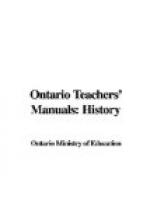Further exercise in composition may also be given by having the pupils write the story. To each pupil may be assigned a special part; for example, the story of Moses may be divided thus: (1) As a babe; (2) His adoption by the Princess; (3) His life at the palace; (4) His flight to Midian; (5) The Burning Bush, etc. The whole story is then reproduced by having these parts read aloud in a reading lesson.
FORM III
The value of the oral work done in Forms I and II will be realized by the teacher when the real study of history is begun in Forms III and IV. The pupils have a liking for the stories of history and have a knowledge of some of the leading actors and of the chief events in history that calls for more complete satisfaction.
There are several methods of using the History Reader which is the basis of the work in Form III. Perhaps the best method is to continue to make oral teaching the chief feature, and to add to that the use by the pupils, in various ways, of the History Reader.
For example, the teacher will tell the story of Jacques Cartier, following in the main the narrative as given in the History Reader. It is well, however, not to follow it too closely in order that, when the pupils come to read the story in the book for themselves, they will find it an interesting combination of the familiar and the new. For that reason, it will be necessary for the teacher to have prepared the story from a somewhat different narrative in some other book at her command. In the telling of the story, problems may be asked, if thought advisable (see p. 33); a few headings may be placed on the black-board for subsequent reproduction, oral or written, by the pupils; all difficulties of pronunciation, especially of proper names, should be attended to, orally and on the black-board; the places mentioned should be found on the map; pictures and sketches should be used; and in fact, every possible means taken to make the narrative more real to the class. (See p. 34.)
When the oral teaching is finished, the pupils may have the books to read at their desks, and they often ask permission to take them home. They may sometimes be required to read aloud from the History Reader for supplementary practice in oral reading. Reproduction by the pupils, either immediately or in a subsequent lesson, should follow. Teachers, however, are advised not to insist on too much written reproduction, as that might very easily arouse a dislike for both history and written composition. Procedure as outlined above has had most gratifying results in the way of creating a liking for, and an intelligent interest in, the study of history.
Other methods have also had good results. The teacher may, instead of telling the story, read aloud from the Reader to pave the way for the reading of the story by the pupils themselves. Difficulties, either in language or in meaning, may be taken up as in a literature lesson. The pupils will at first find the reading somewhat difficult, but the interest generated by the teacher’s reading or oral narrative will carry them through that stage till they acquire a love for reading history, and have enlarged their vocabulary till reading is no longer a burdensome task.




